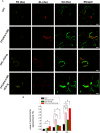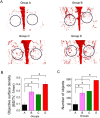Evaluation of Osteogenesis and Angiogenesis of Icariin in Local Controlled Release and Systemic Delivery for Calvarial Defect in Ovariectomized Rats
- PMID: 28698566
- PMCID: PMC5505963
- DOI: 10.1038/s41598-017-05392-z
Evaluation of Osteogenesis and Angiogenesis of Icariin in Local Controlled Release and Systemic Delivery for Calvarial Defect in Ovariectomized Rats
Abstract
Typically, bone regenerative medicine is applied to repair bone defects in patients with osteoporosis. Meanwhile, there is an urgent need to develop safe and cheap drugs that induce bone formation. Icariin, which is reported to promote the osteogenesis of stem cells in vitro, is the main active component of Herba Epimedii. However, whether icariin could repair bone defects caused by osteoporosis remains unknown. In this study, an osteoporosis model in rats was established by an ovariectomy first, and then, the osteogenic and angiogenic differentiation of bone mesenchymal stem cells (BMSCs) treated with icariin was evaluated. Furthermore, calcium phosphate cement (CPC) scaffolds loaded with icariin were constructed and then implanted into nude mice to determine the optimal construction. To evaluate its osteogenic and angiogenic ability in vivo, this construction was applied to calvarial defect of the ovariectomized (OVX) rats accompanied with an icariin gavage. This demonstrated that icariin could up-regulate the expression of osteogenic and angiogenic genes in BMSCs. Meanwhile, osteoclast formation was inhibited. Moreover, CPC could act as a suitable icariin delivery system for repairing bone defects by enhancing osteogenesis and angiogenesis, while the systemic administration of icariin has an antiosteoporotic effect that promotes bone defect repair.
Conflict of interest statement
The authors declare that they have no competing interests.
Figures









Similar articles
-
Icariside II enhances crania defect repair through synergistic angiogenesis and osteogenesis.Tissue Cell. 2025 Aug;95:102833. doi: 10.1016/j.tice.2025.102833. Epub 2025 Mar 7. Tissue Cell. 2025. PMID: 40073468
-
Icariin doped bioactive glasses seeded with rat adipose-derived stem cells to promote bone repair via enhanced osteogenic and angiogenic activities.Life Sci. 2018 Jun 1;202:52-60. doi: 10.1016/j.lfs.2018.02.026. Epub 2018 Feb 20. Life Sci. 2018. PMID: 29471105
-
Icariin-loaded porous scaffolds for bone regeneration through the regulation of the coupling process of osteogenesis and osteoclastic activity.Int J Nanomedicine. 2019 Aug 1;14:6019-6033. doi: 10.2147/IJN.S203859. eCollection 2019. Int J Nanomedicine. 2019. PMID: 31534334 Free PMC article.
-
The effect of icariin on bone metabolism and its potential clinical application.Osteoporos Int. 2018 Mar;29(3):535-544. doi: 10.1007/s00198-017-4255-1. Epub 2017 Nov 6. Osteoporos Int. 2018. PMID: 29110063 Review.
-
Icariin: does it have an osteoinductive potential for bone tissue engineering?Phytother Res. 2014 Apr;28(4):498-509. doi: 10.1002/ptr.5027. Epub 2013 Jul 4. Phytother Res. 2014. PMID: 23824956 Review.
Cited by
-
Osteoclast-derived apoptotic bodies show extended biological effects of parental cell in promoting bone defect healing.Theranostics. 2020 May 22;10(15):6825-6838. doi: 10.7150/thno.45170. eCollection 2020. Theranostics. 2020. PMID: 32550906 Free PMC article.
-
Osteoclast-derived small extracellular vesicles induce osteogenic differentiation via inhibiting ARHGAP1.Mol Ther Nucleic Acids. 2021 Feb 4;23:1191-1203. doi: 10.1016/j.omtn.2021.01.031. eCollection 2021 Mar 5. Mol Ther Nucleic Acids. 2021. PMID: 33664997 Free PMC article.
-
[Effect of icariin on early steroid-induced osteonecrosis of the femoral head in rabbits].Zhongguo Xiu Fu Chong Jian Wai Ke Za Zhi. 2020 Feb 15;34(2):206-212. doi: 10.7507/1002-1892.201905112. Zhongguo Xiu Fu Chong Jian Wai Ke Za Zhi. 2020. PMID: 32030953 Free PMC article. Chinese.
-
Flavonoid-Loaded Biomaterials in Bone Defect Repair.Molecules. 2023 Sep 30;28(19):6888. doi: 10.3390/molecules28196888. Molecules. 2023. PMID: 37836731 Free PMC article. Review.
-
Protection of Icariin Against Hydrogen Peroxide-Induced MC3T3-E1 Cell Oxidative Damage.Orthop Surg. 2021 Apr;13(2):632-640. doi: 10.1111/os.12891. Epub 2021 Feb 22. Orthop Surg. 2021. PMID: 33619876 Free PMC article.
References
Publication types
MeSH terms
Substances
LinkOut - more resources
Full Text Sources
Other Literature Sources

